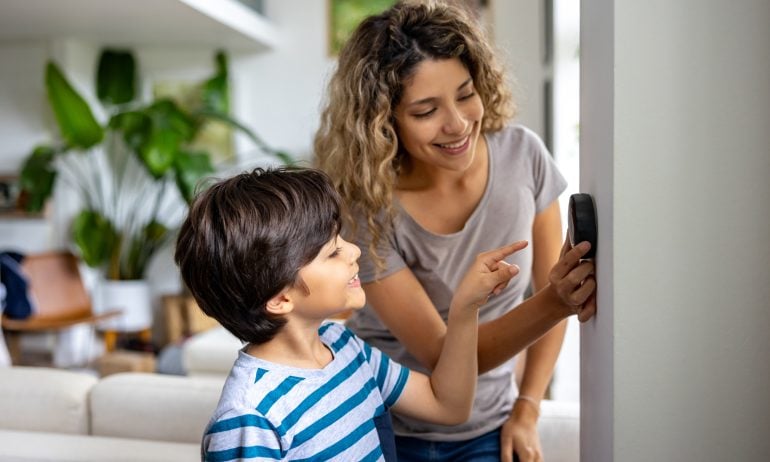You’re our first priority.
Every time.
We believe everyone should be able to make financial decisions with confidence. And while our site doesn’t feature every company or financial product available on the market, we’re proud that the guidance we offer, the information we provide and the tools we create are objective, independent, straightforward — and free.
So how do we make money? Our partners compensate us. This may influence which products we review and write about (and where those products appear on the site), but it in no way affects our recommendations or advice, which are grounded in thousands of hours of research. Our partners cannot pay us to guarantee favorable reviews of their products or services. Here is a list of our partners.
The Cost to Install Central Air in 2024

Writer | Home equity, first-time home buying, home warranties

Assistant Assigning Editor | Mortgage lenders, homebuying, home equity

Some or all of the mortgage lenders featured on our site are advertising partners of NerdWallet, but this does not influence our evaluations, lender star ratings or the order in which lenders are listed on the page. Our opinions are our own. Here is a list of our partners.
Visit your My NerdWallet Settings page to see all the writers you're following.
Summer heats up fast when all you have is a fan to cool you down. Central air conditioning could solve all your sweaty problems, but the price may knock you out cold.
The cost to install central air conditioning, including the cost of the unit itself, ranges from around $5,000 to $10,000 on average, according to the American Society of Home Inspectors, a trade organization. But the price tag varies widely depending on the size of your home and air conditioner, the type of system you choose and your home’s ductwork.
Before embarking on such a large project, you’ll want to understand the factors that impact costs and the financing options that may be right for you.
Breakdown of central air costs
The price of an air conditioning unit is only one piece of the total cost to install central air. You’ll also need to pay for a pre-installation evaluation, possible air duct installation or modification, and a qualified professional in heating, ventilation and air conditioning, or HVAC, to do the work.
Pre-installation evaluation: $250 for a 2,000 square foot home
A Manual J load calculation is the first step in proper installation, according to the American Society of Home Inspectors. This calculation tells contractors how well your home retains heat throughout the day and what size air conditioner will keep it cool.
Ideally, the load calculation would be part of a home energy audit. This assessment identifies air leaks and other issues that increase the cost to run an air conditioner. An energy audit can cost several hundred dollars, but your utility company may offer discounts or rebates. You can also receive a tax credit up to $150 for getting a home energy audit.
Ductwork and design: $500 to $7,500
After the pre-installation evaluation, your contractor should check the systems an air conditioner relies on, especially ductwork, and ensure they can handle central air.
If there’s no existing ductwork, installation could cost between $3,000 and $7,500 for 300 linear feet, according to the home improvement hiring platform Angi.
Even if your home has existing ductwork, it may need to be upgraded if it’s not able to handle the increased airflow coming from the new AC unit. It could also need to be replaced if there are leaks. In this case, the American Society of Home Inspectors estimates that this could cost between $500 and $2,000, or $10 to $20 per linear foot (plus labor costs) if it’s a small section that needs to be replaced.
The type of central air unit: $600 to $24,000
Depending on the size and structure of your home, you’ll choose from the following types:
Central air conditioner: $1,500 to $7,900. This is the most popular choice for homeowners, and, while expensive, can be a very effective option for cooling homes in hot climates. If a contractor has to add ductwork, you’ll need to factor in those costs as well.
Split air conditioning systems: $600 to $20,000. This system has both an indoor and an outdoor cabinet — sort of like a combination of central air and a window unit. The indoor cabinet often contains the furnace, and split systems can be the most economical choice for homes that already have a furnace. They also don’t use ductwork, making them an option for homes without existing ducts.
Geothermal heat pumps: $4,200 to $24,000. These act as both an air conditioner and furnace, extracting hot air from your home and pumping it outside in the summer and pulling heat from underground inside during the winter. Underground temperatures tend to be stable, meaning that geothermal heat pumps are an efficient option even in climates with temperature extremes.
Air-source heat pumps: $3,000 to $8,000. Similar in idea to geothermal pumps, air-source heat pumps circulate air from inside and outside the home to regulate the temperature. Air-source heat pumps are more popular, and often less costly, than geothermal heat pumps.
Size of the AC system
In addition to type, the cost of a central air unit varies by size. An air conditioner’s capacity to cool the air is measured in tons or British thermal units (BTUs); residential systems are generally available in 1.5- to 5-ton capacities. According to Architectural Digest, you can expect to need about 20 BTUs per square foot of interior space.
Installation and labor: $75 to $250 per hour
You can typically expect to pay a contractor between $75 and $250 an hour, depending on what kind of system you’re getting and the level of complexity (such as if ductwork needs to be installed).
To find a high-quality HVAC contractor:
Read online reviews and ask friends for referrals.
Search for contractors on the Air Conditioning Contractors of America website (and use this handy checklist to guide the conversations).
Compare estimates from at least three different companies.
Ask lots of questions about their qualifications and standards.
Seasonal Energy Efficiency Ratio (SEER) Rating
A system’s SEER rating measures its energy efficiency. Systems sold in the U.S. must have a minimum rating of 14 (or 15 in hotter parts of the country); high-efficiency systems have ratings of 18 or higher. Higher efficiency comes with a higher initial price tag, but can save you money in the long run on your energy bill.
3 tips to control central air conditioning installation costs
1. Examine your cooling needs
If you’re an empty nester or only home at night, consider a ductless mini-split air conditioning system. These systems combine an outdoor compressor and condenser with indoor blower vents that can be installed on just about any exterior wall. You might also consider a window unit, which you can install yourself and costs between $150 and $800.
2. Time it right
Scheduling installation in the off-seasons — spring and fall — may yield a lower price or faster turnaround time because HVAC pros aren’t as busy.
3. Look for equipment rebates and tax credits
Local governments, as well as utility companies and manufacturers, promote the use of high-efficiency air conditioners through financial incentives. Use the Energy Star rebate finder to find money-saving opportunities in your ZIP code.
How to finance central air installation
If you’re not planning to pay for your new air conditioning system out of pocket, you have several financing options that you can explore.
Home equity loan
A home equity loan allows you to borrow against your home’s equity (the current value of the home, minus any remaining mortgage balance) and receive a lump sum in the form of a second mortgage, which you pay back at a fixed rate. This loan is secured by your home, which means that you can often get a lower rate than with an unsecured personal loan or credit card. It also means that if you can’t make the required monthly payments, you could lose your home to foreclosure.
According to Angi, a new HVAC system can potentially increase the value of your home by 5% to 7%, further adding to your equity.
» MORE: Best home equity loan lenders
Home equity line of credit
A home equity line of credit (HELOC) operates similarly to a home equity loan, with two major differences. The first is that the interest rate will most likely be variable (moving up or down with the market), unless you seek out a lender that offers a fixed rate option. The other difference is that rather than receiving the loan all at once, you’re granted a line of credit that you can borrow against up to a certain limit for a predetermined amount of time (usually 10 years).
This can be a sensible option for borrowers who are planning a series of home improvement projects beyond the new air conditioning system, since you can continue to borrow as necessary.
» MORE: Best HELOC lenders
Cash-out refinance
If interest rates are lower than your current mortgage rate, you might consider a cash-out refinance. This replaces your existing mortgage with a new, larger loan, with a new rate and repayment terms. The idea is that you use the extra cash to finance your new air conditioning system, wrapping up this payment with your mortgage into one loan.
Cash-out refinances come with closing costs of 2% to 6% of your total loan amount, so the savings from a lower interest rate would need to be large enough to offset this expense.
» MORE: Best cash-out refinance lenders
Personal loan
If you haven’t built up enough equity for a home equity loan or HELOC (or if you want to avoid their added risks), you could finance your new air conditioner unit with a personal loan. These will often come with higher rates, but are not secured by your home and can often be funded relatively quickly.





